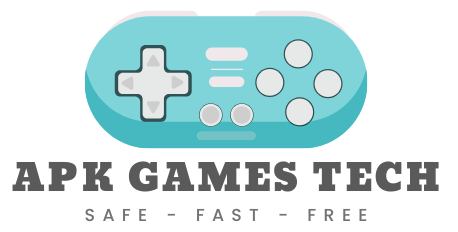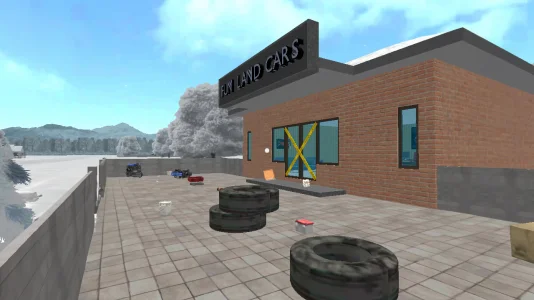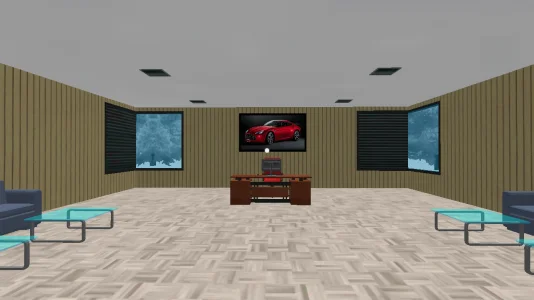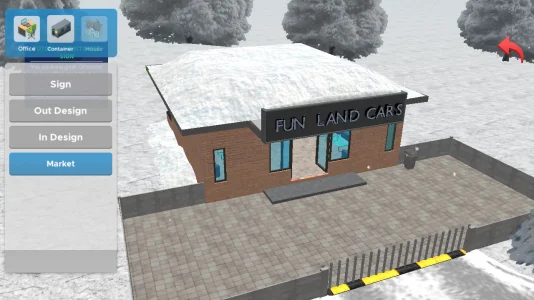Car Saler Simulator Dealership
Screenshots
Content
An In-Depth Analysis of Car Saler Simulator Dealership
Car Saler Simulator Dealership is a single-player management simulation game developed and published by Fun Land Games. This title situates players in the competitive world of the used car market, tasking them with transforming a modest car lot into a thriving dealership empire. The game's design is centered on a core tycoon loop that involves strategic vehicle acquisition, detailed refurbishment, and skillful customer negotiation. Its availability on the Android platform, with a low technical barrier to entry, makes it a highly accessible experience within the mobile gaming ecosystem. However, its operational stability is intrinsically linked to its aggressive free-to-play monetization model, which presents a significant consideration for players.
Core Identity and Technical Specifications
Developer and Genre Classification
The development of Car Saler Simulator Dealership is handled by Fun Land Games, which also acts as the publisher for the title on mobile distribution platforms. The game firmly belongs to the Simulation genre, with strong elements of Management and Tycoon gameplay mechanics. Its design appeals to a casual audience seeking a deep yet approachable business management experience. It is crucial for users to distinguish this mobile title from the similarly named PC game, Car Dealership Simulator, which was developed by Quadfix Games and released in May 2023. The mobile landscape often features titles with analogous names, requiring users to verify the developer as Fun Land Games to ensure they are downloading the correct application.
Platform and Release Information
Car Saler Simulator Dealership primarily targets the Android mobile ecosystem, although related versions are also present on iOS. The application has a significant release history, evidenced by its robust versioning, with recent data referencing Version 1.72. This history of updates, such as the progression from v1.62 to v1.72, indicates a continuous development cycle, assuring the player base that the product receives ongoing maintenance and is not an abandoned project. The game has been available for a considerable period, predating its most recent updates.
System Requirements for Android Devices
The application maintains a low technical threshold, contributing to its widespread adoption. The minimum required operating system is Android 8.1.0+, which covers a vast majority of active Android devices. While the developer does not provide explicit CPU benchmarks, the simulation's nature infers a need for reasonable processing power. A minimum of 2GB of RAM is considered necessary, with 4GB or more being recommended for optimal performance. This higher recommendation stems from user reports indicating that the game's aggressive ad-loading mechanism can strain device resources, leading to freezing and instability on lower-specification hardware. The installed footprint is relatively compact, with the APK file size ranging from 119 MB to 155 MB and the total storage usage after installation estimated between 250 MB and 350 MB.
Connectivity and Offline Capabilities
A key feature of Car Saler Simulator Dealership is its support for offline play. The core management components and the primary Career Mode do not require a persistent internet connection to function. Players can engage in the entire buy-fix-sell cycle without being online. However, internet connectivity becomes mandatory for peripheral functions integral to the game's free-to-play design. These functions include downloading application updates, executing in-app purchases, and, most critically, viewing the frequent video advertisements that underpin the monetization strategy. Paradoxically, a stable internet connection is recommended for this offline-capable game, as slow ad loading has been observed to exacerbate the performance issues reported by users.
Gameplay Architecture and Core Mechanics
Game Modes: From Tycoon to Racing
The gameplay experience is structured entirely around a single-player framework. The central component is the Career Mode, which functions as a dealership tycoon simulation. In this mode, players start with a small enterprise and are responsible for every facet of the business, from sourcing vehicles to managing finances and expanding the physical showroom. Progression leads to the ability to hire employees, such as mechanics and sales personnel, allowing for the automation of tasks and scaling of the business. Complementing the management core, the game includes a competitive element through Drag Races. This mode allows players to compete against others asynchronously for leaderboard placement, providing an incentive for deep vehicle modification and performance tuning.
The Central Gameplay Loop: Buy, Fix, Sell
The foundational gameplay loop of Car Saler Simulator Dealership is a satisfying cycle of value creation. This process involves several distinct stages that require strategic decision-making to maximize profitability. Players must master each step to build their capital and fuel their dealership's growth.
- Vehicle Acquisition: The first step involves sourcing inventory from various locations, each with a different risk-to-reward profile. Cars can be acquired from cheap Neighborhood finds, variable-quality Auctions, Private Sellers, or high-cost Dealerships, which are better suited for collection than for profit flipping.
- Refurbishment and Restoration: Once acquired, vehicles must be repaired and restored. This includes both mechanical fixes managed through a streamlined part-replacement interface and crucial cosmetic work. Cosmetic restoration—involving washing, waxing, sanding rust, and repainting—is a primary driver of value.
- Sales and Negotiation: Restored vehicles are placed in the showroom for sale. The player engages directly with prospective customers, recommending cars and entering into price negotiations. Success in this phase requires patience to achieve the highest possible sale price.
- Growth and Automation: The profits generated from sales are reinvested into the business. Capital is used to upgrade the showroom, improve the service center, and eventually hire staff to delegate repetitive tasks, enabling the business to handle a higher volume of transactions.
Controls and User Interface
The control scheme is fully optimized for mobile touchscreens. Player movement within the 3D environments is managed via a standard virtual joystick. All other interactions, from inspecting a vehicle's condition to navigating menus and engaging in negotiations with customers, are handled through intuitive tap-based commands. The camera can be controlled with swipe gestures, allowing for detailed examination of vehicle inventory. The interface for mechanical repairs is simplified, abstracting complex processes into a user-friendly part-replacement screen accessible via touch.
Strategic Gameplay and Profit Optimization
Prioritizing Cosmetic Refurbishment for Maximum Profit
A critical strategic insight within the game's design is the disproportionate value placed on a vehicle's aesthetic condition. Customer AI appears to weigh the visual appeal of a car more heavily than its mechanical integrity. This structural element dictates that the most efficient path to profitability, especially in the early game, is to allocate resources heavily toward cosmetic repairs. Investing in washing, polishing, rust removal, and fresh paint yields a significantly higher return on investment than expensive mechanical part replacements. Ignoring a car's appearance is one of the quickest ways to undermine potential profit margins.
Advanced Negotiation and Valuation Tactics
Maximizing revenue requires both patience and a willingness to leverage all available mechanics. During customer negotiations, achieving a sale price within the highest bracket (often indicated as a "red" zone in the UI) is possible but demands discipline. Accepting lowball offers for a quick sale sacrifices long-term capital accumulation. Furthermore, the game includes a mechanic for rolling back a vehicle's odometer, which artificially lowers the displayed mileage to increase its perceived value and justify a higher asking price. This ethically dubious tactic represents a direct method of valuation manipulation available to the player.
Monetization Model and Technical Stability
The Free-to-Play Structure and In-App Purchases
Car Saler Simulator Dealership operates on a standard free-to-play model, granting full access to the core simulation experience without any mandatory purchase. In-app purchases are offered, primarily providing players with bulk in-game currency or boosters to accelerate progression. However, the game's financial architecture is predominantly supported by advertisement revenue, which has a profound impact on the user experience.
The Impact of Interstitial Advertising
The implementation of advertisements is the single largest point of friction for players. The game contains frequent and intrusive interstitial ads that can appear in the middle of gameplay actions, disrupting the management flow. This ad delivery system is reportedly poorly optimized, directly causing significant technical instability. User feedback consistently highlights issues where the game freezes or becomes unresponsive during an ad sequence. This instability can also lead to data integrity failures, with reports of daily rewards or mission progress being lost after viewing an ad, creating a high-risk environment for progression.
APK Installation and File Information
Understanding the Integrated APK Package
The application's file structure is designed for user convenience. The APK file size, ranging from 119 MB to 155 MB, indicates an integrated package where all necessary data (traditionally stored in a separate OBB file) is included within the single installation file. This design simplifies the sideloading process, as it eliminates the need for users to manually download and place external data files into specific system folders.
Secure Sideloading Procedure and Troubleshooting
To install the APK, users must first enable "Install unknown apps" from their device's security settings for the browser or file manager being used. After downloading the file from a trusted repository, tapping the APK will initiate the installation prompts. Common errors include "App not installed," which can result from insufficient storage or a conflicting version of the app already on the device, and "Parsing error," which indicates a corrupted file or an incompatible Android version below the required 8.1.0. The most prevalent issue, game freezing, is often linked to ad loading and may be temporarily resolved by clearing the app cache or force-closing and restarting the application.
Conclusion: A Deep Simulation with Technical Caveats
Car Saler Simulator Dealership by Fun Land Games successfully delivers a robust and strategically engaging management simulation. The core mechanics of vehicle flipping, cosmetic restoration, and business expansion are well-realized and provide a rewarding gameplay loop with the added benefit of full offline accessibility. However, the depth of the simulation is critically undermined by an aggressive and poorly optimized monetization strategy. The constant and disruptive interstitial advertisements are a direct cause of prevalent technical instability, including freezing and potential data loss, which severely compromises the user experience. The title is best suited for simulation enthusiasts who can tolerate significant technical friction in exchange for a deep management experience. Users are strongly advised to download the APK only from trusted sources that verify digital signatures to ensure file integrity and avoid potentially malicious repackaged versions.
```An Analytical Guide to Car Saler Simulator Dealership
Car Saler Simulator Dealership is a single-player management simulation game developed by Fun Land Games. The player's primary objective involves transforming a small, rudimentary car lot into a thriving dealership empire. The core gameplay experience centers on a strategic cycle of vehicle acquisition, comprehensive refurbishment, skillful customer negotiation, and the calculated reinvestment of profits. This title's appeal derives from the satisfaction of maximizing profit margins by acquiring distressed automotive assets and restoring their market value through careful management and strategic upgrades.
The game's architecture supports a complete offline career mode, allowing players to engage with the primary management loop without a persistent internet connection. Progression is a function of experience accumulation, which players gain from successful sales and the completion of various in-game challenges. This experience system unlocks access to higher-tier facility upgrades, more profitable vehicle classes, and advanced management capabilities, forming a deep and engaging progression path for dedicated players.
Core Gameplay Mechanics and Systems
Vehicle Acquisition and Sourcing
The foundation of the dealership's success rests on strategic vehicle acquisition. Players source cars from several distinct locations, each presenting a unique risk-to-reward profile. The Neighborhood and Junkyard locations typically offer the cheapest vehicles, which possess high potential for profit but often require extensive and costly repairs. Auctions present variable quality inventory, creating opportunities for significant profit if the player can accurately assess a vehicle's potential value against its bidding price. Private sellers and other dealerships offer higher quality cars at a greater initial cost, making them less suitable for early-game profit flipping but valuable for collection or specialized sales later in the game.
Refurbishment and Value Enhancement
After acquiring a vehicle, the player must engage in a detailed refurbishment process to increase its resale value. This process is divided into two critical categories: mechanical fixes and cosmetic restoration. Mechanical repairs involve a streamlined interface where players replace worn or broken parts. Cosmetic work, however, holds a disproportionately high weight in the game's valuation algorithm. Customers prioritize the visual appeal of a car over its mechanical condition. Therefore, players must strategically allocate resources toward tasks like washing, polishing, sanding rust, applying putty, and repainting. These cosmetic enhancements provide the highest immediate return on investment and are the primary multipliers for a vehicle's final sale price.
The Art of Negotiation
The sales process culminates in a direct negotiation with prospective customers. The player sets an initial asking price and must skillfully manage the customer's offers to secure the best possible deal. The user interface visualizes the acceptable price range, often with a "red zone" that indicates the maximum price a customer is willing to pay. Achieving a sale within this optimal bracket requires significant patience. The game's design directly rewards this behavioral discipline, as consistently securing high-margin sales is fundamental to accelerating capital accumulation and long-term business growth. Accepting quick, low offers directly sacrifices the profits needed for expansion.
Player Progression and Dealership Expansion
Character and Facility Upgrades
Player progression is intrinsically tied to financial success and dealership growth. Successful vehicle sales grant experience points, which elevate the player's level. Leveling up unlocks the ability to purchase critical facility upgrades, such as expanding the physical showroom lot size or improving the service center's capabilities. These upgrades allow the player to hold a larger inventory, perform more advanced repairs, and attract a wider variety of customers. Furthermore, progression unlocks access to more lucrative vehicle classes, including luxury sedans, sports cars, and valuable classic automobiles, which offer substantially higher profit margins.
Automation and Staff Management
As the dealership grows, players unlock the ability to hire employees who can automate certain operational tasks. Mechanics can be hired to handle vehicle repairs, and sales personnel can be employed to manage customer interactions and negotiations. This automation system is crucial for scaling the business, as it frees the player from repetitive tasks and enables a higher volume of sales. However, hiring staff introduces a significant fixed daily cost in the form of wages. Players must make a strategic decision to hire employees only when their operation is consistently profitable and can support the recurring wage expenditure without compromising cash flow.
Strategic Pathways to Success
A Structured Approach for New Players
New players must adopt a disciplined strategy to efficiently build their initial capital. The early phase of the game rewards cautious investment and a focus on high-return activities. Mastering this initial cycle is crucial for establishing a stable financial foundation from which to expand.
- Begin by sourcing the cheapest available vehicles from the neighborhood or junkyard to minimize initial risk.
- Prioritize the allocation of early funds toward cosmetic refurbishment, such as cleaning and rust removal, which delivers the highest return on investment.
- Engage in patient negotiation during every sale, aiming for the highest price bracket to maximize profit from each transaction.
- Reinvest initial profits into high-leverage upgrades like expanding the lot size to increase inventory turnover.
- Delay significant investment in expensive mechanical parts, as their cost often exceeds the value they add to a vehicle in the early game.
Advanced Strategy for Profit Maximization
Experienced players can leverage deeper mechanics to accelerate their progression and maximize profitability. Advanced strategies involve exploiting specific value metrics and optimizing resource allocation. For example, players can use the odometer rollback feature, where available, to artificially lower a car's displayed mileage, thereby boosting its perceived value. As capital becomes more stable, players should focus on specializing in high-margin vehicle classes like sports or classic cars to generate massive profits. Resource optimization also becomes critical; players should use cheaper, used components for basic repairs while reserving expensive performance parts for vehicles intended for drag racing or premium sales.
Competitive Modes and Vehicle Performance
Understanding Asynchronous Drag Racing
Beyond the core management simulation, Car Saler Simulator Dealership features a competitive drag racing mode. This mode allows players to test their modified vehicles against opponents. It is important to understand that this competition is asynchronous. Players compete against ghost data, which may be AI-controlled opponents or records derived from other real players' vehicle configurations, rather than engaging in live Player vs. Player (PVP) events. The primary purpose of this mode is to provide an incentive for deep vehicle modification and performance tuning. Success in drag races often requires significant investment in high-end mechanical parts, creating a strategic choice for players between building cars for maximum profit and building them for maximum speed.
```


